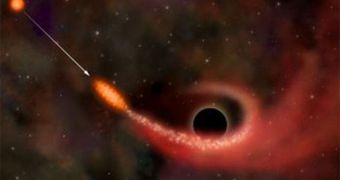Scientists say that the elusive form of radiation that famed theoretical physicist Stephen Hawking predicted back in 1974, and which bears his name, may have just been discovered.
For decades, astrophysicists have been looking for signs that the Hawking radiation is a real, measurable quantity, but thus far their efforts have been in vain.
But their efforts may have literally been misguided, says a team of physicists, which reports having discovered the peculiar form of radiation inside the confines of a science laboratory.
The group that made the finding says that the method the experts used to create the radiation is repeatable and unambiguous, which means that other scientists will have no problem obtaining the same results under the same conditions.
In essence, Hawking radiation are made out of a constant stream of quantum particles. They originate in the events that take place near the event horizon of a black hole.
At the smallest of scale, very tiny particles constantly leap in and out of existence. They appear, form pairs that annihilate each other, and then return their energy to the vacuum that created them.
While in most circumstances this process would be fairly clear-cut, the situation changes drastically when it takes place at the very edge of a black hole.
What Hawking proposed was that, when this happened, one of the particles would get trapped in the black hole, while the other would be free from the tangle, and able to go wherever it pleased.
The physicist's line of thought then added that if this is the case, then a constant stream of tiny particles, the pairs of those attracted through the event horizon of a black hole, would need to emanate from the dark behemoth.
These small particles are essentially what is called Hawking radiation. But subsequent theoretical work by other physicists has demonstrated that event horizons can appear outside black holes as well.
The investigators that made the recent announcement about finding the radiation are based in Italy, at the University of Milan, and are led by expert Franco Belgiorno, Technology Review reports.
They say that they managed the feat by firing an intense laser pulse through a so-called nonlinear material. This type of material allows light to change its refractive index as it passes through.
The complex nature of the interactions that take place inside is described in a paper entitled “Hawking Radiation From Ultrashort Laser Pulse Filaments,” which is published in the online journal arXiv.
The research team says that it accounted for the existence of other factors that may have hampered the results, and that it found the discovery still held true.
Other physicists will now try to replicate the study, and determine whether the conclusion is valid.

 14 DAY TRIAL //
14 DAY TRIAL //